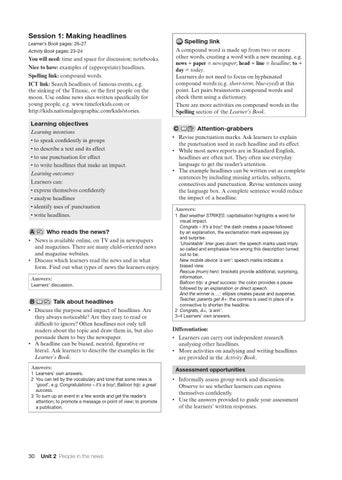Session 1: Making headlines
Spelling link
Learner’s Book pages: 26–27 Activity Book pages: 23–24
You will need: time and space for discussion; notebooks. Nice to have: examples of (appropriate) headlines. Spelling link: compound words. ICT link: Search headlines of famous events, e.g. the sinking of the Titanic, or the first people on the moon. Use online news sites written specifically for young people, e.g. www.timeforkids.com or http://kids.nationalgeographic.com/kids/stories.
Learning objectives Learning intentions • to speak confidently in groups • to describe a text and its effect • to use punctuation for effect • to write headlines that make an impact. Learning outcomes Learners can: • express themselves confidently • analyse headlines • identify uses of punctuation • write headlines.
A
Who reads the news?
• News is available online, on TV and in newspapers and magazines. There are many child-oriented news and magazine websites. • Discuss which learners read the news and in what form. Find out what types of news the learners enjoy. Answers: Learners’ discussion.
B
Talk about headlines
• Discuss the purpose and impact of headlines. Are they always noticeable? Are they easy to read or difficult to ignore? Often headlines not only tell readers about the topic and draw them in, but also persuade them to buy the newspaper. • A headline can be biased, neutral, figurative or literal. Ask learners to describe the examples in the Learner’s Book. Answers: 1 Learners’ own answers. 2 You can tell by the vocabulary and tone that some news is ‘good’, e.g. Congratulations – it’s a boy!, Balloon trip: a great success. 3 To sum up an event in a few words and get the reader’s attention; to promote a message or point of view; to promote a publication.
30
Unit 2 People in the news
A compound word is made up from two or more other words, creating a word with a new meaning, e.g. news + paper = newspaper; head + line = headline; to + day = today. Learners do not need to focus on hyphenated compound words (e.g. short-term, blue-eyed) at this point. Let pairs brainstorm compound words and check them using a dictionary. There are more activities on compound words in the Spelling section of the Learner’s Book.
C
Attention-grabbers
• Revise punctuation marks. Ask learners to explain the punctuation used in each headline and its effect. • While most news reports are in Standard English, headlines are often not. They often use everyday language to get the reader’s attention. • The example headlines can be written out as complete sentences by including missing articles, subjects, connectives and punctuation. Revise sentences using the language box. A complete sentence would reduce the impact of a headline. Answers: 1 Bad weather STRIKES: capitalisation highlights a word for visual impact. Congrats – It’s a boy!: the dash creates a pause followed by an explanation, the exclamation mark expresses joy and surprise. ‘Unsinkable’ liner goes down: the speech marks used imply so called and emphasise how wrong this description turned out to be. New mobile device ‘a win’: speech marks indicate a biased view. Rescue (mum) hero: brackets provide additional, surprising, information. Balloon trip: a great success: the colon provides a pause followed by an explanation or direct speech. And the winner is …: ellipsis creates pause and suspense. Teacher, parents get A+: the comma is used in place of a connective to shorten the headline. 2 Congrats, A+, ‘a win’. 3–4 Learners’ own answers.
Differentiation: • Learners can carry out independent research analysing other headlines. • More activities on analysing and writing headlines are provided in the Activity Book. Assessment opportunities • Informally assess group work and discussion. Observe to see whether learners can express themselves confidently. • Use the answers provided to guide your assessment of the learners’ written responses.
